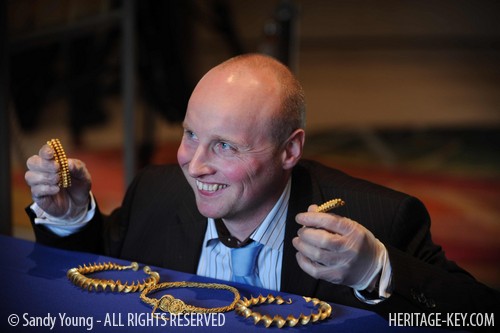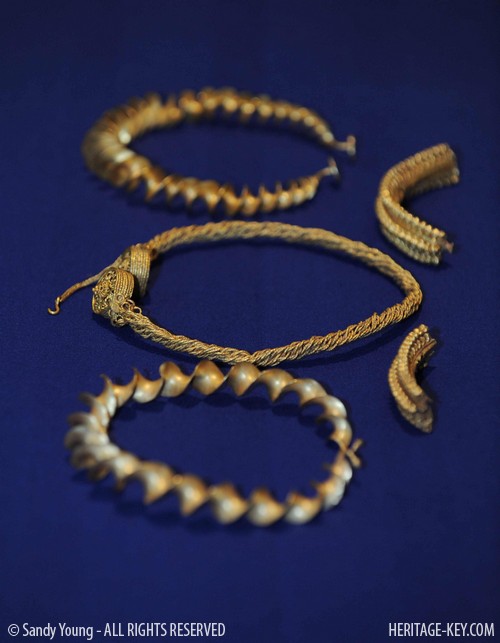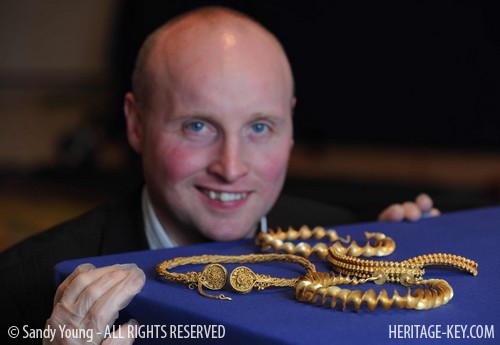 As blogged by Sean yesterday, a precious hoard of Iron Age gold treasures worth an estimated 1 million has been discovered by a first-time metal detector enthusiast near Stirling. It was unveiled to the media at an event at the National Museum of Scotland this morning. The collection was described as the most important hoard of Iron Age gold found in Scotland to date.
As blogged by Sean yesterday, a precious hoard of Iron Age gold treasures worth an estimated 1 million has been discovered by a first-time metal detector enthusiast near Stirling. It was unveiled to the media at an event at the National Museum of Scotland this morning. The collection was described as the most important hoard of Iron Age gold found in Scotland to date.
The Stirling Hoard: Gold Iron Age Torcs
The artefacts four neck ornaments of European significance, dating from between the 1st and 3rd centuries BC were discovered by a local man, David Booth, on private land back in September (the precise location has been kept secret, so as to prevent a mini gold-rush at the spot). One of them is slightly damaged; the others are in near-perfect condition.
Two of the pieces are ribbon torcs, which was a local style of jewellery made from twisting rigid pieces of gold. Another is half of an ornate torc of southern French origin to date the only artefact of its kind found in Britain. The fourth is a unique braided gold wire torc, which shows a strong Mediterranean influence.

They would have most likely belonged to an important and powerful local leader, and been worn as a way of showing off his wealth, importance and ability to trade precious goods with the continent.
What is going to happen to the treasure?
When not out metal detecting, Mr Booth reportedly works as the chief game warden at Blair Drummond Safari Park. He may have fed his last lion if the million pound valuation of the hoard based on the 350,000 figure a similar torc found in Newark, Nottinghamshire in 2005 sold for is accurate.
In accordance with the treasure trove statutes of common Scots law, while the pieces technically now belong to the Crown via The Queens and Lord Treasurers Remembrancer (QLTR) Mr Booth stands to net a sizeable ex-gratia reward payment, since the QLTR generously recognises the contribution of members of the public who make chance finds.
Dr David Caldwell, representing the Treasure Trove Unit the body based at the National Museum of Scotland which is currently holding the items on behalf of the QLTR commented:
The torcs are currently in the care of the Treasure Trove Unit, which is responsible for the care of antiquities found in Scotland on behalf of the Crown. The Treasure Trove Unit along with a team from National Museums Scotland is continuing to excavate and analyse the find.
When and where will the Stirling Hoard go on display?
Its not yet been decided if or when the hoard will go on display. Its up to the Scottish Archaeological Finds Advisory Panel (SAFAP) an independent body, acting on behalf of The Treasure Trove Unit to make that call. Voices have already begun calling for reassurance that the artefacts will remain in Scotland, lest they end up expatriated to an English museum like the Lewis Chessmen.


Dr Fiona Watson, a research associate at the UHI Millennium Institutes Centre for History, yesterday commented to the Scotsman: The neckbands are of such national significance that they must be kept in Scotland. In the past something like this would have gone to London, but there is no way they should leave Scotland.
An official announcement on the hoards fate isnt expected until next year. Until then: feast your eyes on these first pics.